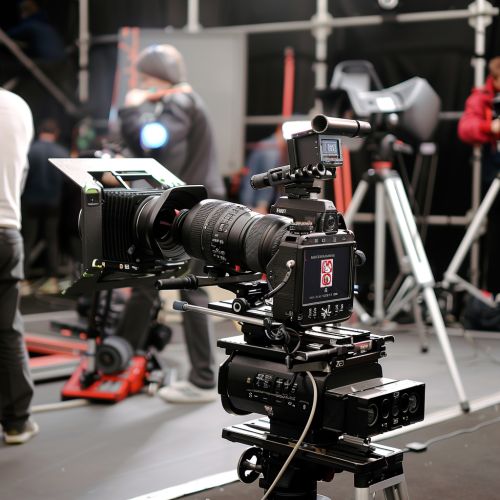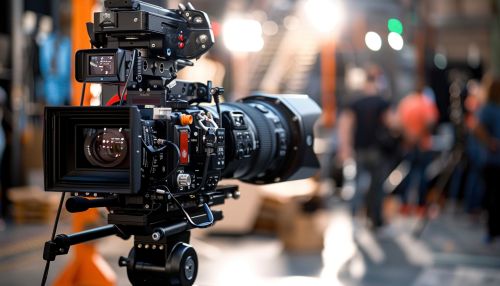Digital filmmaking
Introduction
Digital filmmaking refers to the process of creating motion pictures using digital technology, as opposed to traditional film stock. This method encompasses various stages of production, including pre-production, production, and post-production, all of which leverage digital tools and techniques to enhance the filmmaking process. Digital filmmaking has revolutionized the industry by providing filmmakers with more flexibility, cost-efficiency, and creative possibilities.
History and Evolution
The transition from analog to digital filmmaking began in the late 20th century. Early digital cameras, such as the Sony D1, introduced in 1986, marked the beginning of this shift. However, it wasn't until the late 1990s and early 2000s that digital filmmaking gained significant traction. The release of films like "Star Wars: Episode I – The Phantom Menace" (1999) and "The Blair Witch Project" (1999) showcased the potential of digital technology in mainstream cinema.
The development of high-definition (HD) and later 4K resolution cameras further propelled the adoption of digital filmmaking. Companies like RED Digital Cinema and ARRI introduced cameras that offered superior image quality, dynamic range, and flexibility in post-production. The advent of digital intermediates (DI) allowed filmmakers to manipulate and enhance images with unprecedented precision.
Pre-Production
Pre-production in digital filmmaking involves planning and preparing for the shoot. This stage includes scriptwriting, storyboarding, location scouting, casting, and budgeting. Digital tools such as screenwriting software (e.g., Final Draft) and pre-visualization (previs) software (e.g., FrameForge) streamline these processes.
Scriptwriting
Scriptwriting is the foundation of any film. Digital screenwriting software enables writers to format scripts according to industry standards, collaborate in real-time, and integrate notes and revisions seamlessly. These tools also facilitate the creation of shooting scripts, which are essential for planning the production.
Storyboarding
Storyboarding involves creating visual representations of each scene. Digital storyboarding tools allow filmmakers to sketch, animate, and sequence their storyboards, providing a clear visual roadmap for the production team. This process helps identify potential issues and refine the visual storytelling.
Location Scouting
Location scouting is the process of finding suitable locations for filming. Digital tools like Google Earth and specialized location scouting apps enable filmmakers to explore and document potential locations remotely. These tools also assist in logistics planning, such as determining accessibility and evaluating lighting conditions.
Production
Production is the phase where the film is shot. Digital filmmaking offers numerous advantages during production, including real-time monitoring, immediate playback, and the ability to shoot in various formats and resolutions.
Digital Cameras
Digital cameras are the cornerstone of digital filmmaking. Modern digital cameras, such as the RED EPIC and ARRI Alexa, offer high resolution, wide dynamic range, and flexibility in lens choices. These cameras also support various frame rates and aspect ratios, catering to different creative needs.


Lighting and Sound
Lighting and sound are critical components of film production. Digital lighting equipment, such as LED lights, provides precise control over color temperature and intensity. Digital sound recording devices ensure high-quality audio capture, which is essential for dialogue and sound effects.
Real-Time Monitoring
Real-time monitoring allows filmmakers to review footage immediately after it is shot. Digital monitors and playback systems enable directors, cinematographers, and other crew members to assess the quality of the footage and make necessary adjustments on the spot.
Post-Production
Post-production is the stage where the film is edited, color graded, and finalized. Digital tools have revolutionized post-production by offering advanced editing, visual effects (VFX), and sound design capabilities.
Editing
Digital non-linear editing (NLE) systems, such as Adobe Premiere Pro and Avid Media Composer, allow editors to manipulate footage with precision. These systems support various formats and resolutions, enabling seamless integration of different media types. Editors can also collaborate remotely, streamlining the post-production workflow.
Visual Effects (VFX)
VFX are an integral part of modern filmmaking. Digital VFX tools, such as Autodesk Maya and Adobe After Effects, enable artists to create realistic and fantastical elements that enhance the storytelling. These tools support compositing, 3D modeling, and animation, providing filmmakers with limitless creative possibilities.
Color Grading
Color grading involves adjusting the color and tone of the footage to achieve the desired look. Digital color grading software, such as DaVinci Resolve, offers advanced color correction and grading tools. These tools allow colorists to enhance the visual aesthetics of the film, ensuring consistency and mood.
Sound Design
Sound design encompasses the creation and manipulation of audio elements, including dialogue, sound effects, and music. Digital audio workstations (DAWs), such as Pro Tools, provide comprehensive tools for recording, editing, and mixing audio. Sound designers can create immersive soundscapes that complement the visual storytelling.
Distribution
Digital filmmaking has transformed the distribution landscape. Films can be distributed through various digital platforms, including streaming services, video-on-demand (VOD), and digital downloads. This shift has democratized access to films, allowing independent filmmakers to reach global audiences without traditional distribution channels.
Streaming Services
Streaming services, such as Netflix and Amazon Prime Video, have become major players in film distribution. These platforms offer a vast library of content, accessible to subscribers worldwide. Digital distribution through streaming services provides filmmakers with new revenue streams and exposure opportunities.
Video-on-Demand (VOD)
VOD platforms, such as iTunes and Google Play, allow viewers to rent or purchase films digitally. This model offers flexibility for consumers and additional revenue for filmmakers. VOD platforms also support various formats and resolutions, ensuring high-quality viewing experiences.
Digital Downloads
Digital downloads enable viewers to purchase and download films directly to their devices. This distribution method offers convenience and portability, allowing viewers to watch films offline. Digital downloads also provide filmmakers with control over pricing and distribution terms.
Future of Digital Filmmaking
The future of digital filmmaking is shaped by ongoing technological advancements. Emerging technologies, such as virtual reality (VR), augmented reality (AR), and artificial intelligence (AI), are poised to revolutionize the industry further.
Virtual Reality (VR)
VR technology immerses viewers in a fully interactive and three-dimensional environment. Filmmakers are exploring VR to create immersive storytelling experiences that go beyond traditional cinema. VR filmmaking requires specialized cameras and software to capture and edit 360-degree footage.
Augmented Reality (AR)
AR technology overlays digital elements onto the real world, enhancing the viewer's perception of reality. AR applications in filmmaking include interactive experiences, location-based storytelling, and enhanced visual effects. AR tools enable filmmakers to blend digital and physical elements seamlessly.
Artificial Intelligence (AI)
AI technology is transforming various aspects of filmmaking, from script analysis to post-production. AI-powered tools can analyze scripts for narrative structure, predict audience reactions, and automate editing tasks. AI also enhances VFX and animation by generating realistic simulations and automating repetitive tasks.
Conclusion
Digital filmmaking has revolutionized the film industry by providing filmmakers with advanced tools and techniques to enhance their creative vision. From pre-production to distribution, digital technology has streamlined workflows, reduced costs, and expanded creative possibilities. As technology continues to evolve, digital filmmaking will undoubtedly continue to shape the future of cinema.
